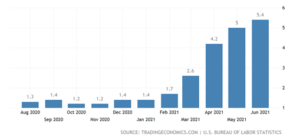Part two of a two-part series.
There were big price shifts up and down in August, making it difficult to pick up a clear signal about inflation. However, if consumers start to perceive higher inflation as normal, it will be.
So, given the potential risk, what are the Biden Administration, Congress and the Federal Reserve doing to keep inflation from raging unchecked? Not much.
Forward guidance. The Fed sometimes says what it plans to do, in the hope that the economy and markets will react favorably. Unfortunately, “forward guidance” can cause problems if the Fed is wrong. And it often is wrong.
Having tried and failed to boost inflation to 2% for about a decade, the Fed expected inflation to remain below 2% beyond 2022. Given low inflation, the Fed indicated that it did not anticipate raising interest rates before 2023.
From February to March 2021, core inflation rose from 1.5% to 2%, which was twice as high as the Fed projected in June 2020, according to The Wall Street Journal. “And so the Fed revised its forecast for 2021 inflation up to 2.2%. By June, inflation had surged to 3.6%, and the Fed again revised its forecast — up to 3.4%.”
While the Fed erred in its prediction, it has not changed its monetary policy and is keeping interest rates near zero.
Tapering. While it is not yet raising interest rates, the Fed has announced that it plans to “taper” its bond purchases by the end of the year, which is like pumping the brakes after driving at full speed since the pandemic began.
The Fed has been purchasing $120 billion worth of bonds each month, swelling its portfolio to more than $8 trillion. Before the Great Recession, it was under $1 trillion. The current level of bond purchases is unprecedented.
In 2013, when then-Fed Chair Ben Bernanke announced that the Fed’s $70 billion in monthly bond purchases would be tapered, a “taper tantrum” took place, even though the Fed reduced asset purchases by only $10 billion per month. By announcing its plans months in advance, the Fed hopes to avoid another tantrum.
More spending. The level of “quantitative easing” (i.e., bond purchasing) is unprecedented, but so is the level of government spending.
The federal government spent $2.4 trillion last year for the Cares Act and even more for other relief measures. This year, as the national lockdown was being lifted, Congress – with no Republican support – approved the $1.9 trillion American Rescue Plan.
More recently, both parties have been negotiating a $1.2 trillion infrastructure bill and Democrats have proposed an additional $3.5 trillion spending bill for entitlements. The Congressional Budget Office estimates the reconciliation bill could actually cost $5.5 trillion.
So after unprecedented stimulus spending since the start of the pandemic, the Democratic Party is focusing its attention not on fighting inflation or controlling the federal debt, but on an unprecedented spending spree that could cause both inflation and the debt to skyrocket.
Higher taxes. To pay for the new spending, Democrats in Congress have proposed $2 trillion in tax increases, as well as greater enforcement of current tax laws and changes in drug-pricing policy.
The plan includes about $1 trillion of tax increases on high-income households and about $1 trillion on corporations, according to the Joint Committee on Taxation. Democrats also expect to generate about $120 billion from tougher tax enforcement and $700 billion from drug-pricing policy changes.
Higher taxes, of course, are not great for economic growth – especially when they affect businesses that crate jobs and high-income taxpayers who spend heavily. Yet the tax proposal suggests the legislation will spur economic growth to generate another $600 billion in revenue. You may see a donkey fly by your window before that happens.
Higher taxes are also inflationary, as businesses pass increased taxes on to consumers.
American economist Thomas Sowell said inflation “is a way to take people’s wealth from them without having to openly raise taxes. Inflation is the most universal tax of all.”
But higher inflation combined with higher taxes is far worse.
More debt. The federal debt is approaching $30 trillion, because spending has continued unabated for many years. We also have more than $150 trillion in unfunded liabilities.
We previously noted that Social Security and Medicare expenditures for 2021 will exceed the payroll taxes and premium payments dedicated to supporting them by $420 billion. It may be even worse than that. Social Security is a pay-as-you-go system. With millions of people still out of work because of the pandemic, the amount collected fell this year. Trustees now say the system will be insolvent by 2033, a year earlier than previously reported.
So it’s not the best time to add trillions more to the debt.
More regulation. The Biden Administration is bringing back many of the regulations that the Trump Administration eliminated. More regulation means an increase in the cost of doing business, which means higher inflation as prices are passed on to consumers.
Higher costs also make American businesses less competitive, which means lower profits and fewer jobs.
Even if inflation is transitory today, the Biden Administration, Congress and the Fed seem determined to make it a long-term problem.

